

|
Home Application Features | Pictures Login Buy Now |
Telepresence robots application survey
No matter what field you are engaged in, the telepresence robot is renewing the way you work, learn, communicate or interact remotely and it will be useful in many different fields. It brings telecommuting employees, remote workers, students, teachers, doctors, patients and family members closer together by giving them a physical presence in real time when they cannot be there in person.
Nowadays telepresence robots provide a lot of benefits for saving money, time and energy and for making our work and life in general more efficient. So, robotic telepresence has a wide range of possible applications as follows:
A telepresence robot can increase the production quality experience, for both employees and customers. The applications for robotic telepresence in manufacturing are numerous. With a telepresence robot, you can oversee the entire process at manufacturing site from anywhere in the world. You can monitor production lines, track inventory and packing, coordinate shipments remotely, and provide real-time assistance to workers on the floor for a better overall workflow.
The benefits of telepresence in the manufacturing sector:
With a telepresence robot, it is not a problem to invite customers into your office, laboratory or manufacturing facility when travel cost or other restrictions prevent them from being there in person.
Nowadays, a lot of companies have several offices or manufacturing facilities located in different parts of the city or even in different cities or countries. To simplify the interection between the branches of the company, as well as to cut down travel costs and save time, telepresence robots can be really helpful.
Some big businessmen prefer inspecting manufacturing facilities (machinery, equipment, manufacturing conditions, etc) before making big deals. Such an inspection is important both for the contractor to attract the client, and for the customer to be confident in the contractor that the works will be done in a proper way.
With a telepresence robot it is also much easier to monitor the manufacturing process at different stages and make sure the production processes and ready-made products are complied with international standards.
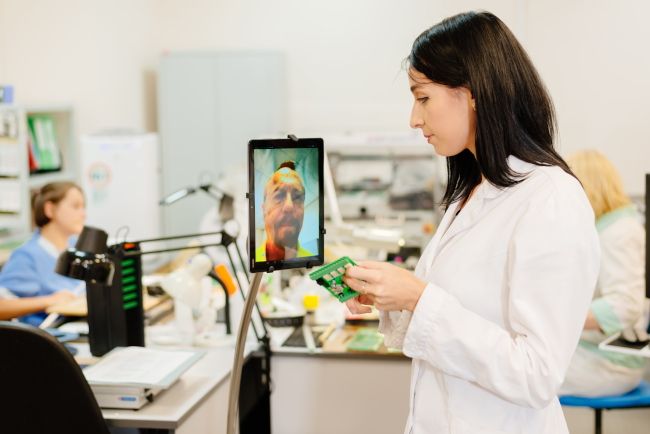
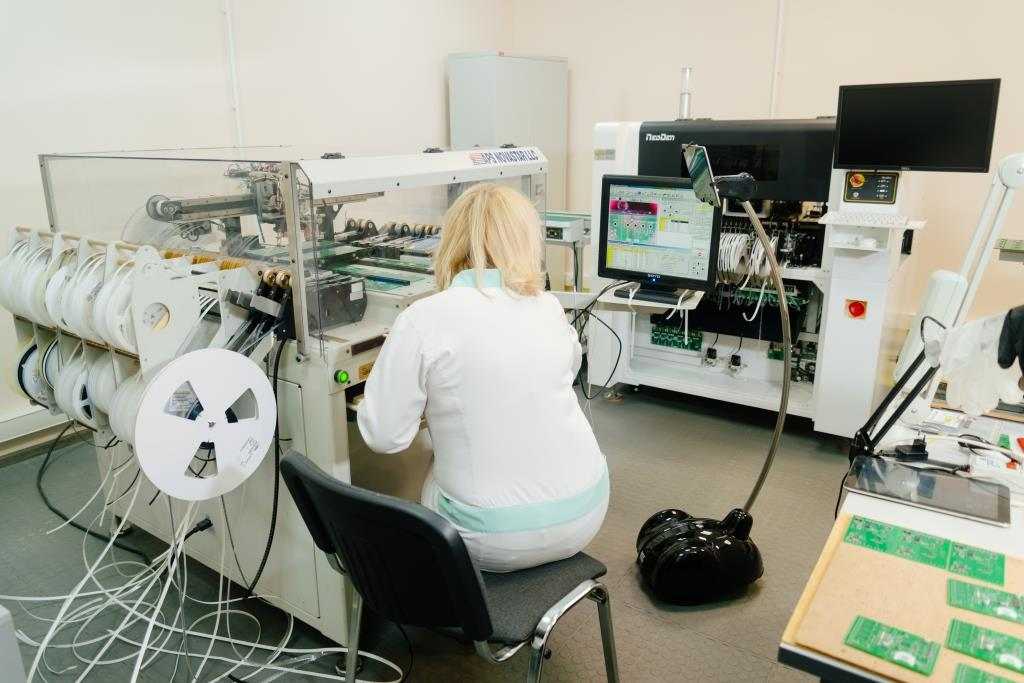
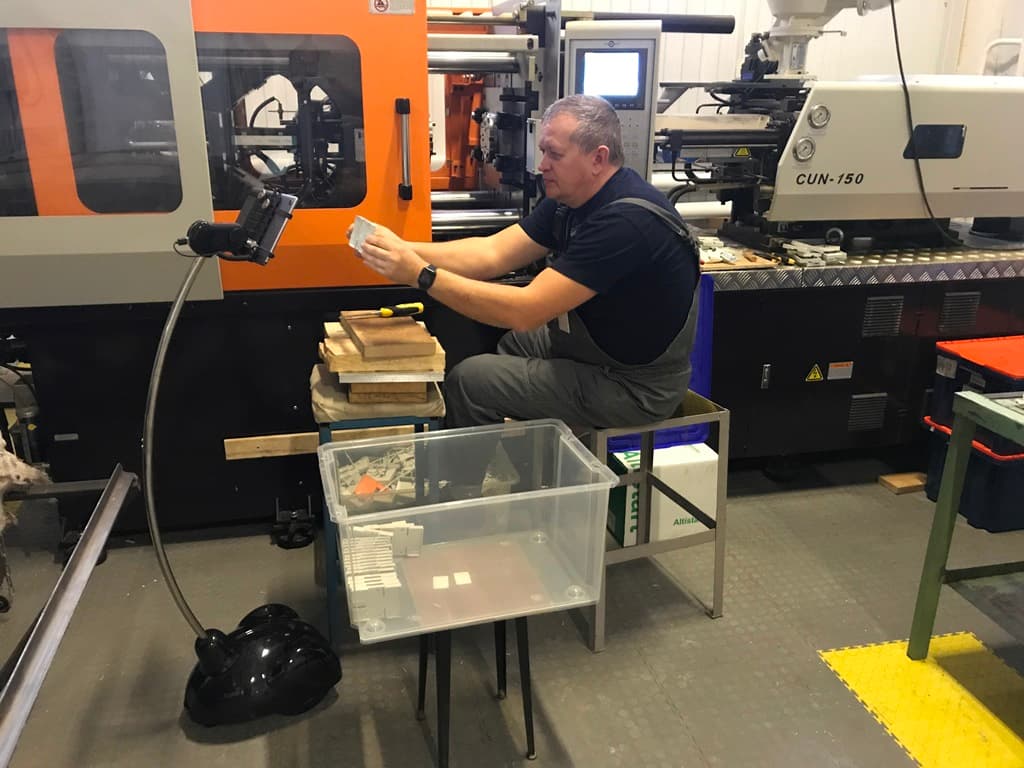
Work is an important component of life taking a lot of our time. Telepresence robots can make our work more efficient. This technology can be reasonably used for the following reasons:
RED Interactive Agency, a digital creative agency, uses the telepresence robot to keep remote employees connected, feeling truly part of the workplace and having normal experience working from day to day. The telepresence robot is a right tool for business because the user is free to move around the office, and the clients, who are spread around the country or all over the world, have a chance to join a meeting remotely, that makes them feel connected in the same way that it works for remote employees.
Watch more here.
Eastern Labs, a financial tech company that is housed within Eastern Bank developing new technology for regional banks specifically, employs two remote programmers who live in Denver and telecommute to Boston every day via a telepresence robot. Thanks to telepresence robot the employees interact with their colleagues, attend every meeting at workplace with seeing people’s faces being able to turn and look at people and be a part of what is going on in the room. Being able to join the team through the presence of the robot creates a better experience for remote employees.
Watch more here.
Accident Fund Group, one of the largest worker's compensation insurance companies in the USA with having branches all over the country, in nine months, has saved between twenty to thirty thousand dollars in costs alone by using the telepresence robot to cut down on travel. The company has about nine scrum teams located anywhere from California to New York, to China, so travel costs are high. As it is important to see faces and reaction, they use the telepresence robot to help them gain some of that on-site experience without having to pay for the travel costs. It is advantageous in meetings to be able to go around, talk to individuals and see individuals in the room.
Watch more: "Case Study: AF Group + Double Robotics."
WeWork company, a provider of coworking spaces, uses the telepresence robot to allow their remote employee in Colorado to telecommute with the team every day to the company's
headquarters in New York. The advantage of telepresence is that it can move to places where a laptop cannot move. Tomer Sharon, the Head of UX, says the robot can stand behind
his shoulders and see what he sees, and also it can see people walking by as they talk.
Watch more here.
Mannapov, LLC, a Texas-based electronics recycling company, deployed some telepresence robots for an extra security. They take their security measures very seriously monitoring their security systems 24/7. The company’s main security guard can control the one of the telepresence robots and roam around the warehouse without having to be out there in that location, and at the same time he can monitor other situations on other cameras without leaving the front desk. The biggest asset of using the telepresence robot is the mobility which allows the security guard to look into situations which the other cameras cannot do, making rounds simpler.
Watch more here.
A Salt Lake City-based restaurant supply company with eight locations leveraged telepresence robots to improve its operational effectiveness and reduce expenses. In their every location they have one of the telepresence robots because it is so easy to be able to see what is going on without having to be physically present at that location.
Watch more here..
Richard Garriott, a video game designer, Portalarium's CEO and private astronaut, uses the telepresence robot from his home in New York almost every day to communicate with his team in Austin, Texas. Garriott calls into his robot in the morning and stays logged into it throughout the day. "It's so close to being there, that we often forget if for certain meetings if I was present physically or 'tele-robotically'," says Garriott. Starr Long, the Executive Producer at Portalarium, believes that the telepresence robot is the best solution for them and that it would be impossible to do their projects without something like a telepresence robot.
Watch more here.
Koupah, a Point of Social platform, combining mobile, social and POS (Point of Sale) in a retail environment, which mission is to build and enhance the customer-retailer
relationship by personalizing the experience, uses the telepresence robot. David Merel, the CEO of Koupah, uses his telepresence robot to be present in the office.
David lives in Westchester and the company’s office is based in Midtown Manhattan. Sometimes it is a little bit difficult for David to get in from Westchester down into the city.
Through the telepresence robot he can telepresence himself and navigate around the office speaking to all the employees. David says that other teleconferencing solutions
out there really have been very limited because he cannot really navigate from computer to computer as easily as he can with the telepresence robot. David feels that Double telepresence robot
has become a great marketing tool not only because it is helping his company save money, but because Double is helping to change the way we communicate with each other,
just like Koupah.
Watch more here.
The usage of telepresence robots can have a huge positive impact on education, where they can be helpful for both students and teachers. Telepresence robots can provide remote access to the classrooms with both online and in-person students and complement the online learning with displaying classroom boards that is extremely important for students who are absent from school for a short or long time due to different reasons. With help of telepresene robots homebound or hospitalized students will be able to follow educational process remotely, join the classroom in realtime, interact with other students face-to-face, and participate in group discussion being strongly involved in communication. This will have a positive effect on students’ success because it contributes to better socialization and interaction with their peers and teachers.
There are also situations when a student is healthy, but lives in another city or in a remote village, from where it is difficult to get to the place of study due to far distance, weather conditions or lack of transport, so a telepresence robot will be helpful in these cases.
This kind of technology enables teachers and professors to continue teaching when they move out of city. Also, different experts can be involved in education with the ability to join the classroom remotely, while maintaining a mobile presence, to give a lecture or master class. The remote expert no longer wastes time getting to destination. It will help save money or re-allocate the budget to other learning activities. In library services this kind of robots can also be used for giving remote tours and showcasing innovative technology.
Remote learning using telepresence robots has found widespread use in the United States. The Internet provides a lot of real stories related to remote learning.
Quite recently, mobile telepresence robots, mostly used by employees to work at a distance, have now been introduced into classrooms for homebound children.
This kind of technology allows the homebound children to control both the camera and the wheels from their home. The child can drive the robot around the classroom and,
thanks to this, is able to go to lunch with other students and attend different classes.
Read more: "My Student is a Robot".
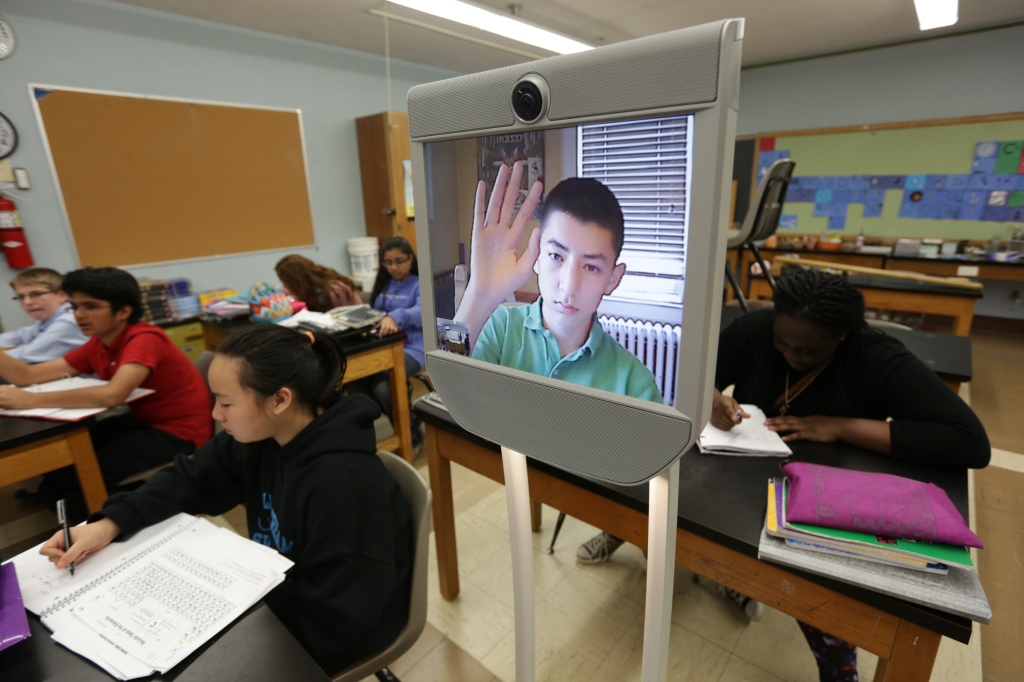
Telepresence robotics allows students who are temporarily unable to attend their classes to continue participating remotely. The University of Colorado Boulder conducted a
pilot study that brought remote students into the classroom using telepresence robots. In spring 2017 they purchased 10 Kubi telepresence robots and 10 iPads to launch a pilot.
They found students who were likely to miss a great number of classes due to different circumstances but who still wanted to attend classroom. Telepresence robots helped students
dealing with difficult situations to attend and participate in their classes remotely, not to withdraw from classes and fall behind academically. The pilot also resulted in that
telepresence robots are most useful in smaller, interactive classes requiring student participation.
Read more Using Telepresence Robots to Support Students Facing Adversity.
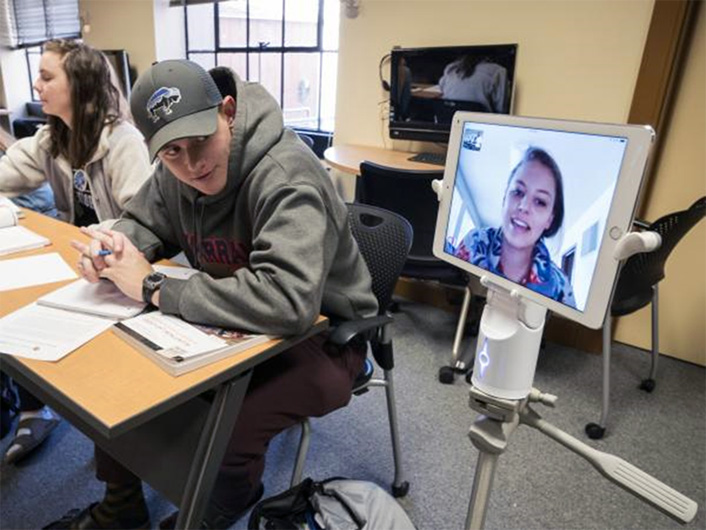
In 2014 10-year old Mason Taylor was diagnosed with blood cancer. He was in the hospital for a few weeks, but his illness then prevented him from returning to school. With a telepresence robot he was able to attend school being navigating the robot around the classroom and participating interactively in the class. Mason controls the robot using the internet, a computer and webcam fron home. His friends help him with a robot at school directing him as he is changing classes. Mason can also ask questions by using a light indicator on the robot. The robot has made all the difference in the word for Mason.
Watch more: Rawlinson MS VGO Robot and Sick kid gets an education via robot.
At the Lone Star Community College the Double robot is used to assist students who cannot attend class in person. There is a program that allows students to check out a robot and essentially drive it into class and attend class virtually.
Watch more here.
Using telepresence robots at the University of Montana gives the opportunity for students from all over the country and the world to interact in the classroom with students
who come to face-to-face classes at university.
Watch more here.
Online Speech Therapy Provider connects students with the future of learning through official partnership with Double Robotics.
Watch more: Robots in Schools.
Thanks to telepresence robots elderly people can live in their homes for longer, staying connected to their family members, friends and caregivers.
The image of the remote user is displayed on the screen and the robot can be driven around to view anything nearby. Most of these robots are controlled from any
location with a computer or smartphone via the internet connection.
Read more Telepresence robots improve patient care.
The telepresence robot allows children diagnosed with cancer at St. Louis Children’s Hospital to visit the St. Louis Science Center. Because hospital-bound children cannot physically visit the museum, Keith Miller, a local computer science professor, collaborating with hospital teachers and child life specialists, has used a telepresence robot nicknamed Celia to help these children feel a bit free and virtually leave their hospital rooms to visit the science center, see and learn about the exhibits. Thanks to Celia, ten-year old Amira Evans, one of the pediatric cancer patient, has been able to break free from her hospital room and look at real dinosaur fossils and see exotic fishes and learned about reefs and ocean ecology.
Read more: Robot helps hospital-bound kids go on ‘virtual’ field trips.
A care provider, Cecilia, visits Aina via the Giraff medical telepresence robot to provide better care. Through the robot Cecilia can make sure if Aina has taken her medicines looking at her pill box. They also have visual interaction with each other.
Watch more: Giraff Provides Better Care | Giraff Medical Telepresence Robot.
AMY medical telepresence robot is helpful in the hospital. Via the robot the doctor communicates with his patient, asks how he is feeling and gives some recomendations. Also the patient can call to his relatives and see them on the robot’s screen in real time.
Watch more: AMY Telepresence Robot in the Hospital.
Duke Raleigh Hospital uses telepresence robot for patient care. During morning rounds in the Duke Raleigh Hospital Intensive Care Unit (ICU), you may see rolling down the hall checking on patients. Jill Galuten, a Duke Raleigh Hospital case manager, has used a telepresence robot called JaMMeR to collaborate with her colleagues and see her patients in ICU while she works remotely during the COVID-19 response.
Watch more: Duke Raleigh Hospital Uses Telepresence Robot For Patient Care.
Ohmni Robot allows patient access by relatives in hospitals, but also “allows nurses and doctors to check in on patients without going through the PPE process,”
said OhmniLabs CEO and co-founder Thuc Vu in an interview with Fierce Electronics.
Read more.
Realizing how it is important for kids to be kids, even when they are in the hospital, Phoenix Children’s Hospital (PCH) has created the Child Life Program to help
young patients prepare for procedures and reduce their anxieties and support healing during hospitalization and illness. The Child Life Program includes the Child Life Zone,
which is a state-of-the-art play area chock full of amenities providing an escape for young patients and their families from daily life in the hospital. Using telepresence
robots in the Child Life Zone is extremely helpful for kids who cannot leave their hospital room to play in person in The Zone and just be kids.
Read more: Ohmni® for hospitalized children: Phoenix Children’s Hospital and watch Ohmni Robot at the Phoenix Children's Hospital.
Robotic telepresence can also be implemented in museum virtual tours. With a telepresence robot, visitors can experience the gallery in a new way. Thanks to telepresence robot an insight into the lived experiences of disabled people can be provided in a creative and collaborative manner.
For example, during the first national lockdown in 2020 Hastings Contemporary began using a telepresence robot to run robot tours, offering a chance to visit the gallery remotely. Passengers on the tours were able to join a member of gallery staff to see a lot of art pieces. This telepresence innovative tool helps arts organisations work to overcome barriers of isolation and exclusion.
The coronavirus pandemic has forced museums and art galleries all over the world to innovate as never before. Closed to prevent the spread of infection, some institutions have started offering virtual viewing rooms, virtual tours and online art classes. Some of institutions have turned to telepresence robotics. At the Hastings Contemporary art museum a telepresence robot was investigating the art on display. Read more: You Can’t Visit the Museum. But Your Robot Can.
CSIRO (Commonwealth Scientific and Industrial Research Organisation) has developed a system that allows remote visitors (students and teachers in regional Australia) to take
part in interactive tours of the National Museum of Australia (NMA) via a web browser and broadband Internet connection. CSIRO developed the technology and installed a system
that enables to participate in live, immersive, interactive, guided tours of the NMA from a computer in their school or local library.
Read more
Using mobile telepresence robots to create unique
virtual museum tours.
Telepresence robots make it possible for disabled people to visit museums. Henry Evans, a mute quadriplegic, suffered a stroke in 2002 that left him with minimal powers of movement except for his head. While lying supine in his Los Altos Hills home in California, with using telepresence robots he was able to take one-on-one guided tours and walk through the collections of the National Museum of Australia in Canberra, the Computer History Museum in Mountain View, California, and the de Young Museum in San Francisco, among others. Read more A Quick Reminder That Technology Can Be Wonderful
With its wheels and cameras zooming in and out, up and down, "Gordon", a telepresence robot, named after the couple behind the bulk of the collection, designed to safely navigate the Baron and Ellin Gordon Art Galleries at Old Dominion University helps people at home visit these institutions remotely. It provides a more “feels-like-you’re-there” experience. It is advantageous that people can reserve a slot for a self-guided tour as part of a group, such as through Google Hangouts, with only one person to drive Gordon using smaller devices such as a tablet or smartphone, or a larger computer.
Read more:
New remote-controlled robot at
Old Dominion University lets visitors tour art galleries from home.
The Zeeuws Museum in Middelburg, a regional museum of art, crafts, history, and identity of the province of Zeeland in the South of the Netherlands, provides virtual tours in Dutch (and English if requested) to everyone worldwide using the telepresence robot ‘GOBE’. People, who visited the museum with a telepresence robot, mentioned the interaction with the tour guide, being able to ask questions and discuss various topics, was the highlight of their tour. The ‘Robots in the Museum’ project enabled the museum to take a close look at its accessibility for different audiences.
Read more: Robots in the Zeeuws museum (Middelburg, the Netherlands)
Telepresence robots can be applied for various events, such as conferences, trade shows, training sessions and exhibitions.
At the annual International Conference on Robotics and Automation (ICRA) which took place in Philadelphia during the last week of May some telepresence robots were used for turning ICRA into a hybrid in-person and virtual event. Three telepresence robots were used for remote attendance by robotics researchers and students during the conference. During the conference people from different parts of the world dialed into the telepresence robots to make presentations, to meet with professors, or to explore the exposition hall and become closer to the state-of-the-art technology on display.
Read more:
The team behind ICRA 2022 used Ohmni telepresence robots.
Use of remote presence technology can also contribute to improving sales productivity, increasing revenue, managing staffing levels and maintaining high level of customer service. It is a new way to help customers navigate the store.
To meet the demands of customers in the best way and to provide new levels of customer service and experiences, smart retailers and businesses are turning to remote presence technology by being able to "teleport" their staff from well-resourced stores into under-resourced stores.
Watch more: Robot Assistant in Retail Stores.